
The University of Idaho is a public land-grant research university in Moscow, Idaho. It was the state's sole university for 71 years, until 1963.

Washington State University is a public land-grant research university in Pullman, Washington, United States. Founded in 1890, WSU is also one of the oldest land-grant universities in the American West. With an undergraduate enrollment of 24,278 and a total enrollment of 28,581, it is the second largest institution for higher education in Washington state behind the University of Washington. It is classified among "R1: Doctoral Universities – Very high research activity".
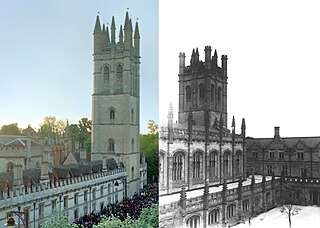
Collegiate Gothic is an architectural style subgenre of Gothic Revival architecture, popular in the late-19th and early-20th centuries for college and high school buildings in the United States and Canada, and to a certain extent Europe. A form of historicist architecture, it took its inspiration from English Tudor and Gothic buildings. It has returned in the 21st century in the form of prominent new buildings at schools and universities including Cornell, Princeton, Vanderbilt, Washington University, and Yale.

Albert Ernest Doyle was a prolific architect in the U.S. states of Oregon and Washington. He opened his own architectural practice in 1907. From 1908 to 1914, he partnered with William B. Patterson, and their firm was known as Doyle & Patterson.

John Charles Olmsted was an American landscape architect. The nephew and adopted son of Frederick Law Olmsted, he worked with his father and his younger brother, Frederick Law Olmsted Jr., in their father's firm. After their father retired, the brothers took over leadership and founded Olmsted Brothers as a landscape design firm. The firm became well known for designing many urban parks, college campuses, and other public places. John Olmsted's body of work from over 40 years as a landscape architect has left its mark on the American urban landscape.
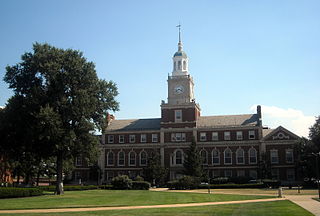
Albert Irvin Cassell (1895–1969) was a prominent mid-20th-century African-American architect in Washington, D.C., whose work shaped many academic communities in the United States. He designed buildings for Howard University in Washington D.C., Morgan State University in Baltimore, and Virginia Union University in Richmond. Cassell also designed and built civic structures for the State of Maryland and the District of Columbia.
Butler Stevens Sturtevant was an American landscape architect.

The campus of the University of Oregon is located in Eugene, Oregon, and includes some 80 buildings and facilities, including athletics facilities such as Hayward Field, which was the site of the 2008 Olympic Track and Field Trials, and McArthur Court, and off-campus sites such as nearby Autzen Stadium and the Riverfront Research Park. An online guide published by the University of Oregon Libraries, Architecture of the University of Oregon, describes campus buildings and provides timelines of key architectural events linked with campus history.
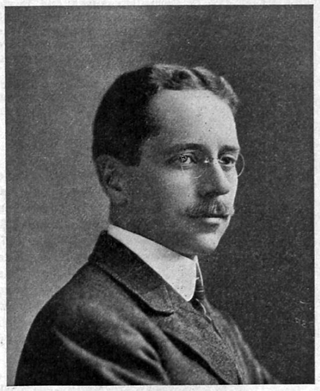
Carl Frelinghuysen Gould also spelled Carl Freylinghausen Gould, was an architect in the Pacific Northwest, and founder and first chair of the architecture program at the University of Washington. As the lead designer in the firm Bebb and Gould, with his partner, Charles H. Bebb, Gould was responsible for many notable Pacific Northwest buildings, such as the original Seattle Art Museum and for the campus plan of the University of Washington.

The College of Built Environments is the architecture and urban planning school of the University of Washington, a public research university in Seattle, Washington.

Paul Thiry (1904–1993) was an American architect most active in Washington state, known as the father of architectural modernism in the Pacific Northwest. Thiry designed "some of the best period buildings around the state of Washington during the 1950, 60s and 70s."

Fred Bassetti was a Pacific Northwest architect and teacher. His architectural legacy includes some of the Seattle area's more recognizable buildings and spaces. The American Institute of Architects (AIA) described his role as a regional architect and activist as having made significant contributions to "the shape of Seattle and the Northwest, and on the profession of architecture."
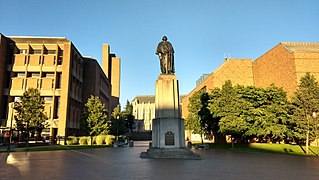
The Campus of the University of Washington is located in the University District of Seattle. Campus buildings are categorized by the major street or vicinity on which they are located on campus. In 2011, Slate magazine and Travel + Leisure described the Seattle campus as one of the most beautiful university campuses in the United States.
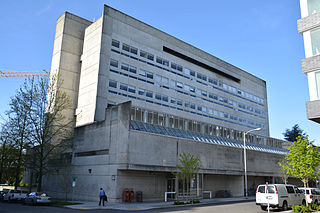
John T. Condon Hall is an academic building of the University of Washington in Seattle, Washington. The building formerly housed the UW School of Law. The hall was named after John T. Condon, the first dean of the School of Law.

Lois Jane Hastings, known on occasion as Jane Hastings, was an American architect, a Fellow of the American Institute of Architects and the first woman to serve as chancellor of the AIA College of Fellows. Her architecture firm, the Hastings Group, designed over 500 mostly residential buildings in the Seattle area.

Northwest Regional style architecture is an architectural style popular in the Pacific Northwest between 1935 and 1960. It is a regional variant of the International style. It is defined by the extensive use of unpainted wood in both interiors and exteriors. Other features of the style include integration of the building with its setting through asymmetrical floor plans, exterior open rooms, extensive use of glass extending to the floor, a low-pitched or flat roof of shingles with overhanging eaves, and a minimum of decoration. It is sometimes known as Northwest style or Northwest modernism.

The architecture of Seattle, Washington, the largest city in the Pacific Northwest region of the U.S., features elements that predate the arrival of the area's first settlers of European ancestry in the mid-19th century, and has reflected and influenced numerous architectural styles over time. As of the early 21st century, a major construction boom continues to redefine the city's downtown area as well as neighborhoods such as Capitol Hill, Ballard and, perhaps most dramatically, South Lake Union.

Scott/Coman Hall is a residence hall complex located on the main campus of Washington State University in Pullman, Washington. It consists of two separate buildings, Coman Hall and Scott Hall.
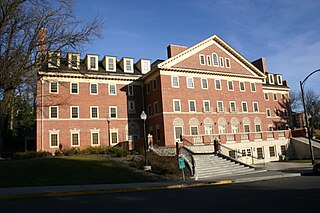
The Elmina White Honors Hall, also known as Honors Hall is a residence hall located on the main campus of Washington State University in Pullman, Washington. It was designed by Stanley Smith, the head of the architecture department at Washington State University (1924-1947), and was completed in 1928. It was later remodeled into student housing and faculty offices in 2001, costing $15.3 million. It is located in the northwest corner of Washington State University (WSU) in Pullman, Washington. Its original purpose was to house the Home Economics department as part of the College of Domestic Economy. Following the 2001 reconstruction, the four-story building, with a converted basement, was transformed into three floors of residential suites with classrooms, offices, and a library for the WSU Honors College on the ground floor, and several multi-purpose rooms in the basement. It was designed in a Georgian Revival style and was referred to as an “elegant architectural statement” in a report provided by the Washington State University Task Force for Historic Preservation in 1985.





















